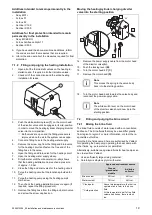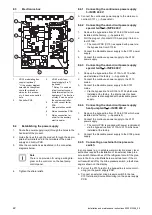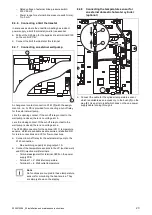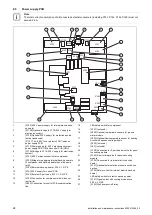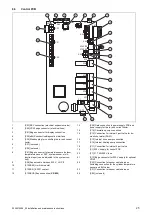
26
Installation and maintenance instructions 0020213394_05
8.7
Connection terminals
8.7.1
X100/S21 ESC contact
A potential-free normally open contact with a breaking capa-
city of 24 V/0.1 A. The function of this contact must be con-
figured in the system control, e.g. switching off the electric
back-up heater when the contact is closed.
8.7.2
X141 signal output for active cooling mode
A contact for connecting a pump for the cooling circuit and/or
an isolation valve for circuits that are not supposed to be
cooled (e.g. bathroom). Max. permitted current: 2 A
8.7.3
X144 external 3-port valve
Contact L has a continuous voltage of 230 V; contact S is a
normally open contact (operated at 230 V) for switching to
the domestic hot water circuit. Max. permitted current at both
connections: 0.2 A
8.7.4
X145 external back-up heater
A contact with potential in order to switch the external heater
on/off on-site via a relay or a contactor. Max. permitted cur-
rent at X145: 0.2 A
8.8
Connecting the system control and
accessories to the electronics system
1.
Install the system control in accordance with the install-
ation instructions supplied.
2.
Open the electronics box. (
3.
Carry out the wiring. (
4.
Connect controls and accessories in accordance with
the relevant basic system diagrams and installation
instructions.
5.
Install the VRC DCF receiver.
6.
Close the electronics box.
8.9
Carrying out the wiring
Caution.
Risk of material damage caused by incor-
rect installation.
Mains voltage at incorrect terminals and plug
terminals may destroy the electronics.
▶
Do not connect any mains voltage to the
eBUS terminals (+/-).
▶
Only connect the power supply cable to
the terminals marked for the purpose.
1.
Route the connection cables of the components to be
connected through the grommet provided on the rear of
the product on the left.
2.
Use the cable trunking on the top of the product.
3.
Use strain reliefs.
4.
Shorten the connection cables as necessary.
30 mm max.
5.
To prevent short circuits if a strand accidentally comes
loose, only strip the outer sheathing of flexible lines to
a maximum of 30 mm.
6.
Ensure the inner conductor insulation is not damaged
when stripping the outer sheathing.
7.
Only strip inner conductors just enough to establish
good, sound connections.
8.
To avoid short circuits resulting from loose individual
wires, fit conductor end sleeves on the stripped ends of
the conductors.
9.
Screw the respective plug to the supply line.
10.
Check whether all conductors are sitting mechanically
securely in the terminals of the plug. Remedy this if
necessary.
11.
Plug the plug into the associated PCB slot.
8.10
Installing the VRC DCF
▶
Install the VRC DCF receiver in accordance with the in-
stallation instructions for the system control.
8.11
Installing optional accessories
1.
Route the lines through the ducts in the back wall of
the product.
2.
Open the electronics box. (
3.
Connect the connection cable to the corresponding
plugs or slots on the power supply PCB or control PCB.
4.
Use the strain reliefs to secure the lines in the product.
8.12
Connecting the circulation pump
1.
Carry out the wiring. (
2.
Connect the 230 V connection cable to the plug from
slot X14 and plug it into the slot.
3.
Connect the connection cable for the external button
using terminals 1 (0) and 6 (functional drawing) on the
X41 edge connector, which is supplied with the control.
4.
Plug the edge connector into slot X41 on the control
PCB.
8.13
Connecting the heat pump system to the
photovoltaic installation
1.
You require the following components for the connec-
tion:
–
External relay box with a relay with one N/O contact
with gold contacts for 24 V/20 mA
2.
Connect the relay contact to the
FB
multi-function input
and to the neutral-ground
0T
on terminal block
X41
on
the heat pump's control PCB.
◁
Contact closed: System saves energy.
◁
Contact open: Heat pump in normal operating
mode
3.
In the basic diagram book, select the
flexoTHERM
/
flexoCOMPACT
basic system diagram and the photo-
voltaic interface.
4.
Configure the relevant settings on the system control
( System control installation instructions).








